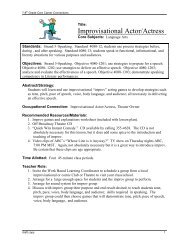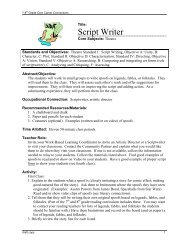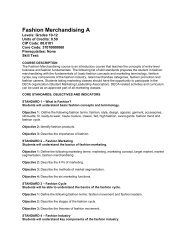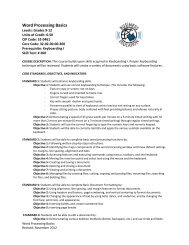What Do You Know About Fetal Alcohol Syndrome
What Do You Know About Fetal Alcohol Syndrome
What Do You Know About Fetal Alcohol Syndrome
You also want an ePaper? Increase the reach of your titles
YUMPU automatically turns print PDFs into web optimized ePapers that Google loves.
<strong>What</strong> <strong>Do</strong> <strong>You</strong> <strong>Know</strong> <strong>About</strong> <strong>Fetal</strong> <strong>Alcohol</strong> <strong>Syndrome</strong>??<br />
<strong>What</strong> is fetal alcohol syndrome and why is it important for you to know about<br />
it? <strong>Do</strong> we know what causes fetal alcohol syndrome? How can fetal alcohol syndrome be<br />
prevented?<br />
Some things to think about...<br />
• How are kids affected by fetal alcohol syndrome?<br />
• How are families affected by fetal alcohol syndrome?<br />
• How can I talk with my parents about fetal alcohol syndrome?<br />
• How many people in the United States have fetal alcohol syndrome?<br />
<strong>Fetal</strong> <strong>Alcohol</strong> <strong>Syndrome</strong> (FAS) True-False Quiz<br />
1. Kids with fetal alcohol syndrome (FAS) have bad behavior all the time.<br />
2. There is no known safe amount of alcohol that can be consumed during pregnancy.<br />
3. A kid who has FAS can be cured.<br />
4. FAS can cause a kid to have difficulty learning.<br />
5. FAS means that a baby is born drunk.<br />
6. If a mother drinks alcohol and has a baby, her baby will always get FAS.<br />
7. It is not dangerous to drink beer while you are pregnant because it is only hard liquor that dangers the<br />
fetus.<br />
8. Children with FAS may have growth deficiencies.<br />
Quick Facts<br />
• <strong>Fetal</strong> alcohol syndrome (FAS) is caused by moms who drink alcohol while they are pregnant.<br />
• Children with FAS often have problems with learning, attention, memory, and problem solving, along with poor<br />
coordination, impulsiveness, and speech and hearing impairments.<br />
• As kids with FAS grow up, school behaviors, emotional, and social problems often get worse<br />
Lesson Plan Ideas for <strong>Fetal</strong> <strong>Alcohol</strong> <strong>Syndrome</strong><br />
Objective 1. To introduce the consequence of alcohol abuse, fetal alcohol syndrome.<br />
Objective 2. Students will investigate the advertisement of alcohol to determine the impact advertisements may have on youth.<br />
Objective 3. Students will discuss options and provide strategies to help prevent FAS.<br />
Activities:<br />
1. <strong>Fetal</strong> <strong>Alcohol</strong> Quiz followed by presentation on what FAS is.<br />
2. Worksheet<br />
3. Using magazines, TV, or web, have students find an alcohol<br />
advertisement to share. Discuss who the ad is marketed for and their<br />
thoughts on the ad.<br />
4. Encourage students to work in groups to begin making Public Service<br />
announcements and advertisements about FAS and prevention.<br />
5. Choose an activity to promote prevention:<br />
Posters in community<br />
Advertisement for school<br />
Public Service<br />
Health Fair booths<br />
Education Standards:<br />
Life Science<br />
The cell<br />
Molecular basis of heredity<br />
Behavior of organisms<br />
Personal and Social<br />
Community Health<br />
Natural and human based hazards<br />
Global challenges
<strong>Fetal</strong> <strong>Alcohol</strong> Worksheet Questions:<br />
A. List some of the physical characteristics of FAS:<br />
<strong>What</strong> <strong>Do</strong> <strong>You</strong> <strong>Know</strong> <strong>About</strong> <strong>Fetal</strong> <strong>Alcohol</strong> <strong>Syndrome</strong>??<br />
Some answers may be: Small head, small eyes, folds on ears, small for age, flat midface, thin upper lip, short nose, etc.<br />
B. Compare the sizes of the brain with the FAS and the brain without FAS. <strong>What</strong> areas are most affected?<br />
Some answers may be: FAS brain much smaller, has fewer folds and incomplete separation. Frontal Lobes effected. Left and<br />
Right side functions inhibited.<br />
C. <strong>What</strong> is the prevalence of FAS in the US?<br />
1.5-3 per 1000 birth in the United States, approximately 1200 births a year<br />
D. How can FAS be prevented?<br />
It is 100% preventable when women do not consume alcohol during pregnancy.<br />
<strong>Fetal</strong> <strong>Alcohol</strong> Spectrum Disorder is completely preventable. It is the #1 cause of mental retardation in the United States today. Learn<br />
the facts, understand the cause, and then look towards helping prevent this disease.<br />
Over 55% of women are drinking when they become pregnant. One newborn in every 100 births will have disabilities from alcohol<br />
consumed during the pregnancy. Learn how we can begin to reduce these statistics and begin to develop programs to prevent <strong>Fetal</strong><br />
<strong>Alcohol</strong> Spectrum Disorder.<br />
<strong>You</strong>th can become peer teachers to help instruct and prevent this disease. Teen councils can take a stand to become actively involved<br />
in promoting the awareness of this disease, which can lead to prevention.<br />
The 1000’s of youth who suffer from this disease also need understanding and help. These youth and adults are in today’s society<br />
having trouble learning, focusing and paying attention. With understanding of their problems you can become a resource to help these<br />
youth reach a fuller potential.<br />
We can do it; we can help reduce the number of babies born with <strong>Fetal</strong> <strong>Alcohol</strong> <strong>Syndrome</strong>!<br />
Outline:<br />
This power point presentation provides factual information about <strong>Fetal</strong> <strong>Alcohol</strong> <strong>Syndrome</strong> and <strong>Fetal</strong> <strong>Alcohol</strong> Effects. This<br />
presentation provides a definition, cause of the problem, cost of alcohol use, and some ideas to help combat this, the number one cause<br />
of mental retardation in the United States.<br />
<strong>You</strong>th and youth leaders have the power to prevent this syndrome. Awareness is critical. A few states do a fairly good job of providing<br />
information about the FAS, but the majority of them do not. We can NOT just encourage youth to avoid alcohol; we must show them<br />
the reasons why it is critical to avoid the use of alcohol if pregnancy COULD occur.<br />
On an average, each <strong>Fetal</strong> <strong>Alcohol</strong> individual will cost the taxpayer more than $3 million in his or her lifetime. This includes health,<br />
special education, psychotherapy, counseling, welfare, crime and the justice system.<br />
Research from this presentation comes from:<br />
National Organization for <strong>Fetal</strong> <strong>Alcohol</strong> <strong>Syndrome</strong>- http://www.nofas.org/resource/factsheet.aspx<br />
Center for Disease Control - http://www.cdc.gov/ncbddd/fas/<br />
United States Department of Health and Human Services - Office of Surgeon General<br />
Carolyn Washburn (carolyn.washburn@usu.edu)<br />
Utah State University Extension<br />
Washington County<br />
“Utah State University is an affirmative action/equal opportunity institution.’”
















